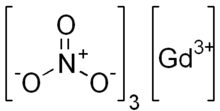Gadolinium(III) nitrate
Gadolinium(III) nitrate is an inorganic compound of gadolinium. It is used as a water-soluble neutron poison in nuclear reactors.[1] Gadolinium nitrate, like all nitrates, is an oxidizing agent.
 | |
| Identifiers | |
|---|---|
3D model (JSmol) |
|
| ChemSpider | |
| ECHA InfoCard | 100.030.385 |
PubChem CID |
|
CompTox Dashboard (EPA) |
|
| |
| |
| Properties | |
| Gd(NO3)3 | |
| Molar mass | 343.26 g/mol |
| Appearance | White crystalline solid |
| Density | 2.3 g/cm3 |
| Melting point | 91 °C (196 °F; 364 K) |
| Soluble | |
| Hazards | |
| Safety data sheet | External MSDS |
Except where otherwise noted, data are given for materials in their standard state (at 25 °C [77 °F], 100 kPa). | |
| Infobox references | |
Use
Gadolinium nitrate was used at the Savannah River Site heavy water nuclear reactors and has to be separated from the heavy water for storage or reuse.[2][3] The Canadian CANDU reactor, a pressurized heavy water reactor, also uses gadolinium nitrate as a water-soluble neutron poison in heavy water.
Gadolinium nitrate is also used as a raw material in the production of other gadolinium compounds, for production of specialty glasses and ceramics and as a phosphor.
gollark: Someone can sign up for an account using a differently dotted version of your email, and it'll seem like one which is actually directed to you.
gollark: Or, er, not-really-phishing.
gollark: Because phishing attacks.
gollark: It;s a really stupidisoiasufi feature.
gollark: Can we do a capitalist takeover instead?
References
- DOE Fundamentals Handbook: Nuclear Physics and Reactor Theory (PDF). U.S. Department of Energy. January 1993. p. 31. Archived from the original (PDF) on 2008-04-23. Retrieved 2007-09-26.
- E. Wilde; C. Berry. "Novel Method for Removing Gadolinium from Used Heavy Water Reactor Moderator".
- E.W. Wilde; M.B. Goli; C.J. Berry; J.W. Santo Domingo; H.L. Martin. "Novel Method for Removing Gadolinium from Used Heavy Water Reactor Moderator" (PDF).
Salts and covalent derivatives of the nitrate ion
| HNO3 | He | ||||||||||||||||
| LiNO3 | Be(NO3)2 | B(NO 3)− 4 |
RONO2 | NO− 3 NH4NO3 |
HOONO2 | FNO3 | Ne | ||||||||||
| NaNO3 | Mg(NO3)2 | Al(NO3)3 | Si | P | S | ClONO2 | Ar | ||||||||||
| KNO3 | Ca(NO3)2 | Sc(NO3)3 | Ti(NO3)4 | VO(NO3)3 | Cr(NO3)3 | Mn(NO3)2 | Fe(NO3)2 Fe(NO3)3 |
Co(NO3)2 Co(NO3)3 |
Ni(NO3)2 | CuNO3 Cu(NO3)2 |
Zn(NO3)2 | Ga(NO3)3 | Ge | As | Se | Br | Kr |
| RbNO3 | Sr(NO3)2 | Y(NO3)3 | Zr(NO3)4 | Nb | Mo | Tc | Ru(NO3)3 | Rh(NO3)3 | Pd(NO3)2 Pd(NO3)4 |
AgNO3 Ag(NO3)2 |
Cd(NO3)2 | In | Sn | Sb(NO3)3 | Te | I | Xe(NO3)2 |
| CsNO3 | Ba(NO3)2 | Hf | Ta | W | Re | Os | Ir | Pt(NO3)2 Pt(NO3)4 |
Au(NO3)3 | Hg2(NO3)2 Hg(NO3)2 |
TlNO3 Tl(NO3)3 |
Pb(NO3)2 | Bi(NO3)3 BiO(NO3) |
Po(NO3)4 | At | Rn | |
| FrNO3 | Ra(NO3)2 | Rf | Db | Sg | Bh | Hs | Mt | Ds | Rg | Cn | Nh | Fl | Mc | Lv | Ts | Og | |
| ↓ | |||||||||||||||||
| La(NO3)3 | Ce(NO3)3 Ce(NO3)4 |
Pr(NO3)3 | Nd(NO3)3 | Pm(NO3)3 | Sm(NO3)3 | Eu(NO3)3 | Gd(NO3)3 | Tb(NO3)3 | Dy(NO3)3 | Ho(NO3)3 | Er(NO3)3 | Tm(NO3)3 | Yb(NO3)3 | Lu(NO3)3 | |||
| Ac(NO3)3 | Th(NO3)4 | PaO2(NO3)3 | UO2(NO3)2 | Np(NO3)4 | Pu(NO3)4 | Am(NO3)3 | Cm(NO3)3 | Bk | Cf | Es | Fm | Md | No | Lr | |||
This article is issued from Wikipedia. The text is licensed under Creative Commons - Attribution - Sharealike. Additional terms may apply for the media files.